
The Abingtons are a community in South Cambridgeshire consisting of two small villages: Little Abington and Great Abington, about 7 miles (11 km) south east of Cambridge.
The Wilburton-Wallington Phase is the name given by archaeologists to a metalworking stage of the Bronze Age in Britain spanning the period between c. 1140 BC and c. 1020 BC.

Beachamwell is a village and civil parish in the Breckland district of Norfolk, England about 5 miles (8.0 km) south west of Swaffham and 10 miles (16 km) east of Downham Market. It has four ancient churches, two of them in ruins. The former parish of Shingham has been annexed.

Swineshead is a village and civil parish in the Borough of Bedford in the county of Bedfordshire, England.

St Andrew's Church is a redundant Anglican church standing in an isolated position in fields about 2 kilometres (1.2 mi) to the north of the village of Woodwalton in Huntingdonshire, Cambridgeshire, England. It is about 200 metres (219 yd) to the east of the East Coast Main Line and is visible from the passing trains. The church is recorded in the National Heritage List for England as a designated Grade II* listed building, and is under the care of the Friends of Friendless Churches. As of 2010 it is not regularly open to visitors because its foundations are moving and it is unsafe.
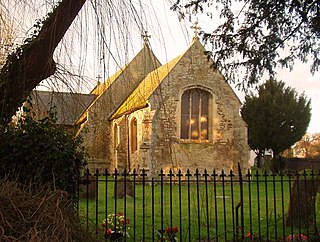
St George's Church, Little Thetford, is an Anglican church in the village of Little Thetford, Cambridgeshire, England.
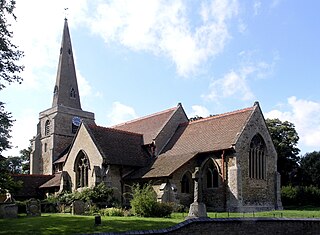
St James' Church, Stretham, is an active Anglican church in the village of Stretham, Cambridgeshire, England. Founded in the 12th century, it was heavily restored by the architect J. P. St Aubyn in 1876. English Heritage, a body responsible for preserving historical sites in the United Kingdom, assessed the church a Grade II* listed building. The turret clock on the east face of the tower was also made in 1876, by JB Joyce & Co of Whitchurch, Shropshire, and still keeps good time. The church has a ring of six bells hung for change ringing. Regular ringing resumed at the church in June 2011 after several years' silence. St James' is one of eight churches in the Ely Team Ministry.
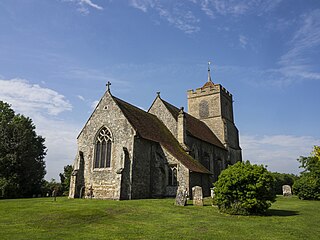
St Andrew's Church is a redundant Anglican church in the village of Buckland, Hertfordshire, England. It is recorded in the National Heritage List for England as a designated Grade II* listed building, and is under the care of the Churches Conservation Trust. The church stands at the highest point in the village to the east of Ermine Street, now the A10 road, between Royston and Buntingford.
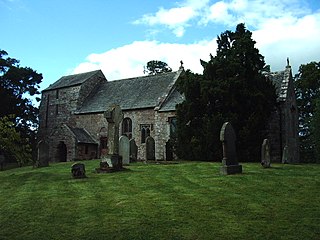
St James' Church is in the village of Great Ormside, Cumbria, England. It is an active Anglican parish church in the deanery of Appleby, the archdeaconry of Carlisle, and the diocese of Carlisle. The parish is united with nine other parishes and thirteen places of worship to form the Heart of Eden benefice. The church is recorded in the National Heritage List for England as a designated Grade I listed building. It stands on top of a circular mound overlooking the River Eden.
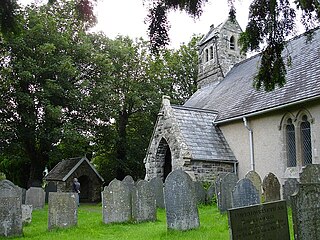
Llangadfan is a small village in Powys, Wales, based in the community of Banwy. The village lies on the A458 between Foel and Llanerfyl, 12 kilometres (7.5 mi) from Llanwddyn. Dyfnant Forest is located nearby. The village is said to be known for its country dances.

St Eugrad's Church, Llaneugrad is an isolated church near the village of Marian-glas, in Anglesey, north Wales. A church was supposedly founded here by St Eugrad in about 605, although the earliest parts of the present structure are the nave, chancel and chancel arch, which date from the 12th century. A side chapel was added to the north in the 16th century, and some moderate restoration work was carried out in the 19th century. It contains a 12th-century font, a 13th-century carved stone depicting the crucifixion, and a memorial to one of the officers killed when the Royal Charter sank off Anglesey in 1859.

St Mary's Church, Llanfair-yng-Nghornwy is a medieval parish church in the north-west of Anglesey, north Wales. The date of foundation of the church, which is in the village of Llanfair-yng-Nghornwy, is unknown, but the oldest parts date from the 11th or 12th century. It has twice been enlarged: in the 15th century, when the chancel was rebuilt, and in the 16th century, when a chapel was added to the south of the chancel, separated by three arches. The tower at the west end is from the 17th century. A south porch of unknown date has been converted into a vestry, and the church is now entered through the tower.

St Michael's Church is in Church Lane, Aughton, Lancashire, England. It is an active Anglican parish church in the deanery of Ormskirk, the archdeaconry of Wigan & West Lancashire, and the diocese of Liverpool. Its benefice is united with that of Holy Trinity, Bickerstaffe. The church is recorded in the National Heritage List for England as a designated Grade I listed building.

St Lawrence's Church is in the village of Crosby Ravensworth, Cumbria, England. It is an active Anglican parish church in the deanery of Appleby, the archdeaconry of Carlisle, and the diocese of Carlisle. Its benefice is united with those of five local churches to form The Leith-Lyvennet Group of Parishes. The church is recorded in the National Heritage List for England as a designated Grade I listed building.

St Cuthbert's Church is located near the village of Edenhall, Cumbria, England. It is an active Anglican parish church in the deanery of Penrith, the archdeaconry of Carlisle, and the diocese of Carlisle. Its benefice has been united with those of seven local parishes to form the Cross Fell Group of churches. The church is recorded in the National Heritage List for England as a designated Grade I listed building. It stands to the southeast of the village, and is surrounded by parkland.
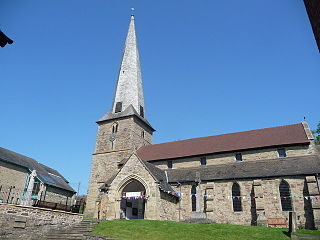
St Mary's Church is on Church Street, Cleobury Mortimer, Shropshire, England. It is an active Anglican parish church in the deanery of Ludlow, the archdeaconry of Ludlow, and the diocese of Hereford. Its benefice is united with those of six local parishes to form the Cleobury Benefice. The church is recorded in the National Heritage List for England as a designated Grade I listed building. It is notable for its shingled twisted spire.

St Robert's Church, Pannal, North Yorkshire, England, also known as St Robert of Knaresborough Parish Church, is a Grade II* listed building. A 13th-century wooden church dedicated to St Michael was rebuilt in sandstone in the 14th century by monks of the Trinitarian Order from Knaresborough Priory. It was perhaps then that it was rededicated to Robert of Knaresborough. Its nave was rebuilt in the 18th century, restored in the 19th and remodelled in the 20th. Extensions were added in the 20th century. It is a parish church, and the vicar also serves the Church of St Michael and All Angels, Beckwithshaw.
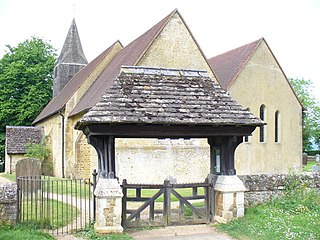
St James's Church stands on Abinger Lane in Abinger Common, a small village within the civil parish of Abinger in Surrey, south-eastern England. The church was built in the early 12th century and then rebuilt around 1220, and is today a grade II* listed building.

St Mary Magdalene's Church, East Ham is a parish church in East Ham, east London, dedicated to St Mary Magdalene. Its nave, chancel and apse date to the first half of the 12th century and the tower probably to the early 13th century but partly rebuilt in the 16th century - it is claimed to be the oldest parish church still in weekly use in Greater London and is listed at Grade I.

St Peter's Church is a Church of England parish church in the large village of Henfield, West Sussex. Placed on the site of an 8th-century Saxon church also dedicated to St Peter, it was built in the 13th, 14th and 15th centuries, but was heavily restored and partially rebuilt in the 19th century. English Heritage has listed it at Grade II* for its architectural and historical importance. Services for the parish continue and also cover the parishes of St Giles', Shermanbury and St. Peter's, Woodmancote, which form its united benefice.























